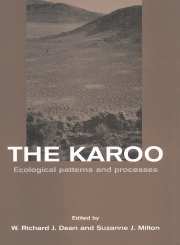Book contents
- Frontmatter
- Contents
- List of contributors
- Foreword
- Preface
- Acknowledgements
- Part one Biogeographic patterns and the driving variables
- Part two Form and function
- 6 Form and function in perennial plants
- 7 Functional aspects of short-lived plants
- 8 Plant reproductive ecology
- 9 Animal form and function
- 10 Animal foraging and food
- Part three Dynamics
- Part four Human impacts
- Part five Comparisons
- References
- Index
7 - Functional aspects of short-lived plants
Published online by Cambridge University Press: 23 December 2009
- Frontmatter
- Contents
- List of contributors
- Foreword
- Preface
- Acknowledgements
- Part one Biogeographic patterns and the driving variables
- Part two Form and function
- 6 Form and function in perennial plants
- 7 Functional aspects of short-lived plants
- 8 Plant reproductive ecology
- 9 Animal form and function
- 10 Animal foraging and food
- Part three Dynamics
- Part four Human impacts
- Part five Comparisons
- References
- Index
Summary
Introduction
Life in hot deserts is challenging for plants as they face severe physiological stress from drought and heat. Even during the rainy season, the availability of moisture is unpredictable in timing, amount and space (Mott and Chouard, 1979). There are two main survival strategies of plants growing under these conditions; firstly drought tolerance, which is usually exhibited by perennial plant species, and secondly, drought avoidance, a strategy common in short-lived species. In this chapter, short-lived plants include all those that complete their entire life cycle within one year and whose shoot and root systems die after seed production. To contrast these species with perennials (Midgley and Van Der Heyden, this volume), the term annual will be used in this chapter although most of the species complete their life cycles within a much shorter period.
Annual plants in hot deserts are frequently considered as paragons of adaptation (Mulroy and Rundel, 1977; Fox, 1992). The view that adaptation is important in the evolution of these plants is persuasive because these features are repeated among related taxa in deserts around the world (Gutterman, 1982). Moreover, the annual habit is thought to be a derived trait in most angiosperm taxa (Johnson, 1968; Axelrod, 1979).
Annuals constitute a large percentage of the flora of hot deserts, and this fraction tends to increase with environmental variability (Schaffer and Gadgil, 1975; Fox, 1989). The annuals, as a percentage of the flora of a number of sites in the karoo, are compared with the normal spectrum (Mueller-Dombois and Ellenberg, 1974) as well as with other desert areas in Table 7.1.
- Type
- Chapter
- Information
- The KarooEcological Patterns and Processes, pp. 107 - 122Publisher: Cambridge University PressPrint publication year: 1999
- 8
- Cited by



